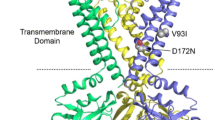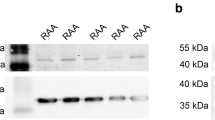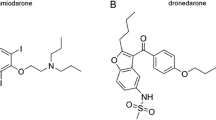Abstract
Ajmaline is a class Ia anti-arrhythmic compound that is widely used for the diagnosis of Brugada syndrome and the acute treatment of atrial or ventricular tachycardia. For ajmaline, inhibitory effects on a variety of cardiac K+ channels have been observed, including cardiac Kv1 and Kv4 channels. However, the exact pharmacological properties of channel blockade have not yet been addressed adequately. Using two different expression systems, we analysed pharmacological effects of ajmaline on the potassium channels Kv1.5 and Kv4.3 underlying cardiac I Kur and I to current, respectively. When expressed in a mammalian cell line, we find that ajmaline inhibits Kv1.5 and Kv4.3 with an IC50 of 1.70 and 2.66 μM, respectively. Pharmacological properties were further analysed using the Xenopus expression system. We find that ajmaline is an open channel inhibitor of cardiac Kv1.5 and Kv4.3 channels. Whereas ajmaline results in a mild leftward shift of Kv1.5 activation curve, no significant effect on Kv4.3 channel activation could be observed. Ajmaline did not significantly affect channel inactivation kinetics. Onset of block was fast. For Kv4.3 channels, no significant effect on recovery from inactivation or channel deactivation could be observed. Furthermore, there was no use-dependence of block. Taken together, we show that ajmaline inhibits cardiac Kv1.5 and Kv4.3 channels at therapeutic concentrations. These data add to the current understanding of the electrophysiological basis of anti-arrhythmic action of ajmaline.






Similar content being viewed by others
References
Arora RB, Madan BR (1956) Antiarrhythmics. VI. Ajmaline and serpentine in experimental cardiac arrhythmias. J Pharmacol Exp Ther 117:62–67
Bébarová M, Matejovic P, Pásek M et al (2005) Effect of ajmaline on transient outward current in rat ventricular myocytes. Gen Physiol Biophys 24:27–45
Blaauw Y, Gögelein H, Tieleman RG et al (2004) “Early” class III drugs for the treatment of atrial fibrillation: efficacy and atrial selectivity of AVE0118 in remodeled atria of the goat. Circulation 110:1717–1724. doi:10.1161/01.CIR.0000143050.22291.2E
Caballero R, Gómez R, Núñez L et al (2004) Diltiazem inhibits hKv1.5 and Kv4.3 currents at therapeutic concentrations. Cardiovasc Res 64:457–466. doi:10.1016/j.cardiores.2004.07.022
Dhein S, Müller A, Gerwin R, Klaus W (1993) Comparative study on the proarrhythmic effects of some antiarrhythmic agents. Circulation 87:617–630
Ehrlich JR, Biliczki P, Hohnloser SH, Nattel S (2008) Atrial-selective approaches for the treatment of atrial fibrillation. J Am Coll Cardiol 51:787–792. doi:10.1016/j.jacc.2007.08.067
Feng J, Wible B, Li GR et al (1997) Antisense oligodeoxynucleotides directed against Kv1.5 mRNA specifically inhibit ultrarapid delayed rectifier K+ current in cultured adult human atrial myocytes. Circ Res 80:572–579
Friedrich O, Wegner FV, Wink M, Fink RHA (2007) NA+- and K+-channels as molecular targets of the alkaloid ajmaline in skeletal muscle fibres. Br J Pharmacol 151:82–93. doi:10.1038/sj.bjp.0707194
Gogelein H, Brendel J, Steinmeyer K et al (2004) Effects of the atrial antiarrhythmic drug AVE0118 on cardiac ion channels. Naunyn Schmiedeberg’s Arch Pharmacol. doi:10.1007/s00210-004-0957-y
Khodorov BI, Zaborovskaya LD (1983) Blockade of sodium and potassium channels in the node of Ranvier by ajmaline and N-propyl ajmaline. Gen Physiol Biophys 2:233–268
Khodorov BI, Zaborovskaya LD (1986) Use-dependent blockade of sodium channels by local anaesthetics and antiarrhythmic drugs. Effects of chloramine-T and calcium ions. Drugs Exp Clin Res 12:743–752
Kiesecker C, Zitron E, Lück S et al (2004) Class Ia anti-arrhythmic drug ajmaline blocks HERG potassium channels: mode of action. Naunyn Schmiedeberg’s Arch Pharmacol 370:423–435. doi:10.1007/s00210-004-0976-8
Kohlhardt M, Fichtner H, Fröbe U, Herzig JW (1989) On the mechanism of drug-induced blockade of Na+ currents: interaction of antiarrhythmic compounds with DPI-modified single cardiac Na+ channels. Circ Res 64:867–881
Köppel C, Wagemann A, Martens F (1989) Pharmacokinetics and antiarrhythmic efficacy of intravenous ajmaline in ventricular arrhythmia of acute onset. Eur J Drug Metab Pharmacokinet 14:161–167
Madeja M, Musshoff U, Speckmann EJ (1997) Follicular tissues reduce drug effects on ion channels in oocytes of Xenopus laevis. Eur J Neurosci 9:599–604
Manz M, Lüderitz B (1993) Supraventricular tachycardia and pre-excitation syndromes: pharmacological therapy. Eur Hear J 14(Suppl E):91–98
Manz M, Mletzko R, Jung W, Lüderitz B (1992) Electrophysiological and haemodynamic effects of lidocaine and ajmaline in the management of sustained ventricular tachycardia. Eur Hear J 13:1123–1128
Patel SP, Campbell DL, Morales MJ, Strauss HC (2002) Heterogeneous expression of KChIP2 isoforms in the ferret heart. J Physiol (Lond) 539:649–656
Rolf S, Haverkamp W, Borggrefe M et al (2000) Effects of antiarrhythmic drugs on cloned cardiac voltage-gated potassium channels expressed in Xenopus oocytes. Naunyn Schmiedeberg’s Arch Pharmacol 362:22–31
Sakuta H, Okamoto K, Watanabe Y (1992) Blockade by antiarrhythmic drugs of glibenclamide-sensitive K+ channels in Xenopus oocytes. Br J Pharmacol 107:1061–1067
Scherer D, Hassel D, Bloehs R et al (2009) Selective noradrenaline reuptake inhibitor atomoxetine directly blocks hERG currents. Br J Pharmacol 156:226–236. doi:10.1111/j.1476-5381.2008.00018.x
Scholz EP, Welke F, Joss N et al (2011) Central role of PKCα in isoenzyme-selective regulation of cardiac transient outward current Ito and Kv4.3 channels. J Mol Cell Cardiol 51:722–729. doi:10.1016/j.yjmcc.2011.07.012
Singarayar S, Bursill J, Wyse K et al (2003) Extracellular acidosis modulates drug block of Kv4.3 currents by flecainide and quinidine. J Cardiovasc Electrophysiol 14:641–650
Tian D, Frishman WH (2011) Vernakalant: a new drug to treat patients with acute onset atrial fibrillation. Cardiol Rev 19:41–44. doi:10.1097/CRD.0b013e3181f4a6a2
Uebele VN, England SK, Gallagher DJ et al (1998) Distinct domains of the voltage-gated K+ channel Kv beta 1.3 beta-subunit affect voltage-dependent gating. Am J Physiol 274:C1485–C1495
van der Heyden MAG, Wijnhoven TJM, Opthof T (2006) Molecular aspects of adrenergic modulation of the transient outward current. Cardiovasc Res 71:430–442. doi:10.1016/j.cardiores.2006.04.012
Wang Z, Feng J, Shi H et al (1999) Potential molecular basis of different physiological properties of the transient outward K+ current in rabbit and human atrial myocytes. Circ Res 84:551–561
Wettwer E, Hála O, Christ T et al (2004) Role of I Kur in controlling action potential shape and contractility in the human atrium: influence of chronic atrial fibrillation. Circulation 110:2299–2306. doi:10.1161/01.CIR.0000145155.60288.71
Williams CP, Hu N, Shen W et al (2002) Modulation of the human Kv1.5 channel by protein kinase C activation: role of the Kvbeta1.2 subunit. J Pharmacol Exp Ther 302:545–550. doi:10.1124/jpet.102.033357
Wirth KJ, Paehler T, Rosenstein B et al (2003) Atrial effects of the novel K(+)-channel-blocker AVE0118 in anesthetized pigs. Cardiovasc Res 60:298–306
Wolpert C, Echternach C, Veltmann C et al (2005) Intravenous drug challenge using flecainide and ajmaline in patients with Brugada syndrome. HRTHM 2:254–260. doi:10.1016/j.hrthm.2004.11.025
Acknowledgments
This work was supported by grants from DFG Zi1177/1-1, Scho1350/1-1 and Scho1350/2-1 (to E.Z. and E.P.S.). F.F. is supported by the Hartmut Hoffmann-Berling International Graduate School of Molecular and Cellular Biology. D.S. was supported by the Postdoc Fellowship of the Faculty of Medicine, University of Heidelberg. The skilful assistance of Christine Jeckel is gratefully acknowledged.
Conflict of interest
None
Author information
Authors and Affiliations
Corresponding author
Rights and permissions
About this article
Cite this article
Fischer, F., Vonderlin, N., Zitron, E. et al. Inhibition of cardiac Kv1.5 and Kv4.3 potassium channels by the class Ia anti-arrhythmic ajmaline: mode of action. Naunyn-Schmiedeberg's Arch Pharmacol 386, 991–999 (2013). https://doi.org/10.1007/s00210-013-0901-0
Received:
Accepted:
Published:
Issue Date:
DOI: https://doi.org/10.1007/s00210-013-0901-0




